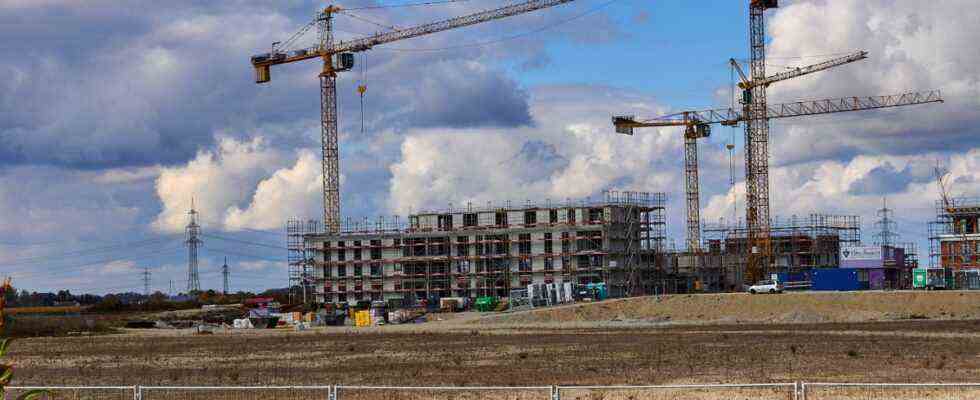The construction industry is growing, both in Bavaria and in the Ebersberg district. But that does not automatically mean that there are no problems there. Andreas Wolfbauer, from K. Wolfbauer GmbH and the Ebersberg construction guild, says that the order situation is “unbroken very good”. Markus Huber from Huma GmbH can confirm this. Wilhelm Schuhböck, Managing Director of the Austrian Swietelsky AG, which also has a branch in the district, differentiates the picture somewhat. In building construction, the order situation is “still good”, in civil engineering and road construction, however, only “satisfactory to poor”https://www.sueddeutsche.de/muenchen/ebersberg/.” Especially in asphalt road construction, which is predominantly dependent on public clients is, it’s bad,” he lets know.
Raw materials and materials are becoming more and more expensive
The waiting time before a new order can be accepted is therefore only two to four weeks. In building construction, it can sometimes take twelve months, the other companies also confirm. Irrespective of the order situation, Markus Huber also points out that although sales may increase, this does not automatically translate into higher profits. In particular, high raw material prices are causing problems for his company in this regard.
In road construction, the picture shows the expansion of the district road EBE 8 in autumn 2020, the order situation is less good. The contracting authorities are holding back.
(Photo: Peter Hinz-Rosin)
The latest figures from the Bavarian State Office for Statistics are of little consolation. At the end of September 2021, the main construction trades had orders on hand worth 13.6 billion euros, 8.6 percent more than in the previous year. In 2020, all of the main construction trades together achieved sales of almost 30 billion euros, which corresponds to an increase of 12.4 percent compared to the previous year. In June of this year, as a comparative figure, growth continued: 2.5 billion euros were turned over, which means growth of 1.8 percent.
More workers are being sought than are found
In Upper Bavaria, growth in 2020 was slightly below average at 9.4 percent, which corresponds to sales of around nine billion euros. But not only sales, but also employment figures have increased in the past year and a half. At the end of June this year, the number of Bavarian construction companies was 14,132, with 173,576 employees. This corresponds to an increase of 4.6 percent more companies and 2.8 percent more employees than in 2020. So growth as far as the eye can see.
However, the fact that all that glitters is not concrete is shown by the much-lamented shortage of skilled workers, which also affects the district. Markus Huber’s relatively small company could use one or two new employees, Wilhelm Schuhböck speaks of a “serious” shortage of well-trained workers. Andreas Wolfbauer also points out that the situation is aggravated by quarantine requirements after crossing the border and that there is a lot of construction activity.
Large construction sites, here in Grafing in 2015 on the former brewery site, need many skilled workers, but they are rare.
(Photo: Peter Hinz-Rosin)
All three assume that the construction boom and the shortage of skilled workers will continue unabated in 2022. The demand for single-family homes is falling, but there is high demand for apartments, especially in the Munich suburbs, as Andreas Wolfbauer points out. “This is also because the price of a house is too high, the land prices are too high,” he explains.
Sustainable building is trendy, but it costs money
In the age of climate change, it is also legitimate to ask whether growth, as the only metric for the health of an economic system, has not taken care of it. According to the federal government, 14 to 28 percent (depending on whether you include the production of electricity and district heating as well as building materials) of all CO2 emissions in Germany come from the building sector.
Thermal insulation, here GWG apartments on Zornedinger Straße in Munich, has been subsidized for years. In other areas, however, the construction companies still see a need.
(Photo: Florian Peljak)
Accordingly, it is good to hear that there is a noticeable trend towards more sustainable construction in the district. Markus Huber points out that thermal insulation is now subsidized by the state and is therefore used more often. “That’s not really the case with building materials,” he says. Wilhelm Schuhböck can also state that there is a higher demand for wood and wood-hybrid construction methods in building construction. Andreas Woflbauer agrees, but also worries: “Of course, sustainable building is a big issue and is also aspired to. But it’s also a major cost driver, which is driving real estate prices up again.”
Despite good growth figures, it remains to be seen whether the concrete that means the world will soon give way to more boards.

